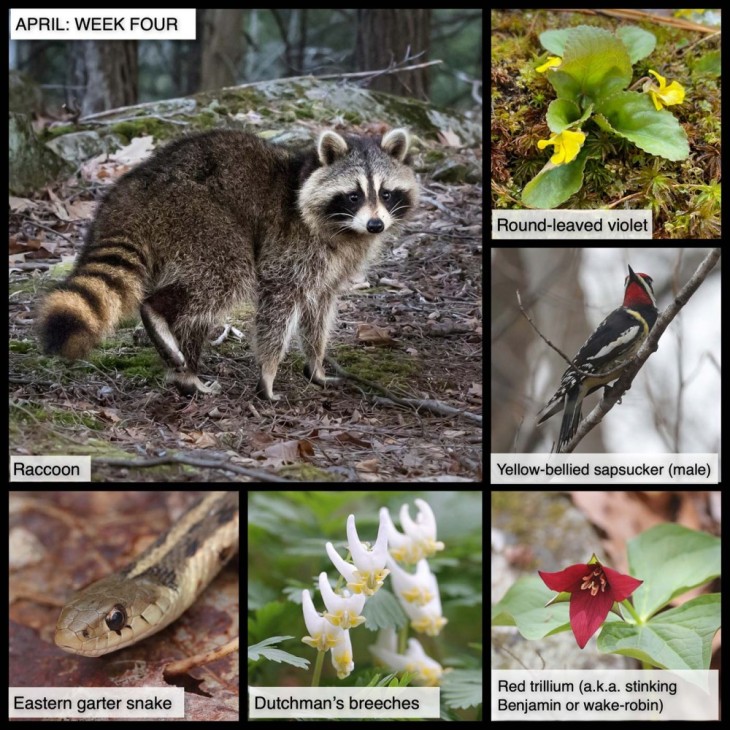This Week in the Woods, this handsome raccoon passed our remote camera. It was likely heading to a nearby vernal pool for a frog feast; this time of year, we often find raccoon tracks in the mud there. As explained by Tim Traver in this Outside Story essay, raccoons “evolved around river and lake banks in South America where they had to use their forepaws to find food hidden under water or buried in mud and silt.” Traver notes that their forepaws are sensitive – about five times more than most paws, with a comparable number of mechanoreceptor cells to human hands – and although they lack opposable thumbs, they’re incredibly dexterous. As Meghan McCarthy McPhaul notes in this second Outside Story essay, raccoons breed in late winter and very early spring, and their young are typically born in April.
Here are some other nature sights this week (clockwise):
Round-leaved violet, also called round-leaf yellow violet, is one of the first violets to bloom in spring, and its yellow flowers are now a common sight in woodlands. If you inspect a flower closely, you’ll see purple-to-reddish veining in the lower petals. Notice also the crinkly edge of its leaves. Here’s an Outside Story essay by Laurie Morrissey, describing common wild species of viola (“about 30 in the northeastern states and Canada”).
It isn’t really spring until you’ve been dive-bombed by a yellow-bellied sapsucker, which happened to us a few days ago. We were walking along the edge of a woods, minding our own business, but apparently got uncomfortably close to two males in a territorial spat. One swooped over our head; we took this photo and hurried away. As shown, the males have beautiful red throat plumage (both genders have red crowns), which they fluff up when they’re courting or aggravated. Here’s a profile from Cornell Lab’s All About Birds website.
Red trillium, a.k.a. wake-robin or stinking Benjamin, is now blooming in the woods. As noted in this profile from the U.S. Forest Service, it tends to appear in relatively dry, acidic soil (although it seems less fussy than the later-blooming painted trillium, and we’ve found it in a range of habitats). In common with many other spring woods wildflowers, red trilliums benefit from myrmecochory, a fancy, fun word meaning “the dispersal of seeds by ants.”
And speaking of myrmecochory…Dutchman’s breeches also uses this dispersal trick. This little wildflower is blooming now, often sprouting out of rock crevices. Its feathery leaves may give it an early spring advantage; as noted in this blog post quoting Wesleyan University professor Dana Royer, “Teeth boost transpiration and photosynthate production early in the growing season, maximizing carbon gain when temperature is limiting.”
Finally, we found this eastern garter snake on the cold forest floor, apparently too sluggish to do much more than flick its tongue as we took its picture. Snakes aren’t known for their expressive faces, but we’d characterize this look as “disgruntled” with a side of “I came out of hibernation for this?!” With temperatures warmer now, the snake is presumably feeling zippier and hunting small prey. As Susan Shea notes in this Outside Story essay, garter snakes’ diet includes insects, worms, small mammals, and the occasional nestling bird. They’re useful to have around lawns and gardens as a natural control for plant-eating pests.
Our thanks to The Bailey Charitable Foundation and the Frank and Brinna Sands Foundation for helping to support this series.
In this difficult period, many of us find joy in observing local nature. This series, launched in April 2020, shares nature photographs taken in the past seven days, or in the same week in 2020, most within 15 miles of the Northern Woodlands office in Lyme, New Hampshire. We hope you enjoy using this grid as a prompt for your own explorations.
What are you seeing in the woods this week? Share your images with us on Facebook, or submit a special photo for possible inclusion in our monthly online Reader Photo Gallery.


